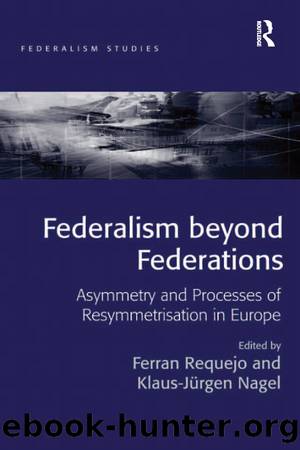Federalism Beyond Federations: Asymmetry and Processes of Resymmetrisation in Europe by Ferran Requejo & Klaus-Jürgen Nagel

Author:Ferran Requejo & Klaus-Jürgen Nagel [Requejo, Ferran & Nagel, Klaus-Jürgen]
Language: eng
Format: epub
Tags: Political Science, World, European
ISBN: 9781409489115
Google: 24dBAz5aqH4C
Goodreads: 17552724
Publisher: Ashgate Publishing
Published: 2011-01-01T00:00:00+00:00
The Evolution of the Autonomy of the à land Islands
Already during the first two decades of the implementation of the autonomy legislation, the à land Islanders became aware of an unintentional resymmetrisation that depended on changing circumstances after the independence of Finland and on the fact that as an independent state, Finland was obliged to enter into treaties on different matters with other states. In the 1920 Act on Self-Government, the legislative competences between the Finnish Parliament on the one hand and the Legislative Assembly of the à land Islands on the other were divided so that the Finnish Parliamentâs powers were enumerated in a list of substantive fields, including foreign affairs and matters regulated in international treaties, while the powers of the à land Islandsâ Legislative Assembly were residual and would concern all other fields of legislation.20
From a formal point of view, such a division of powers is typical of older federations, where the constituent states were left in the possession of residual powers that the federal level was not supposed to encroach upon.21 In the case of the à land Islands, however, the attribution of foreign relations and especially treaty powers to the national sphere of competence led, during the first decades of the autonomy arrangement, to the realisation that with increasing treaty-making activity, the legislative powers of the national law-maker were increasing at the expense of the à land Islandsâ legislative powers. The reference in the national list of competencies to the matters included in international treaties resulted in a de facto transfer of law-making powers to the Finnish Parliament in a way which threatened the existence of viable law-making powers on the à land Islands. In terms of the EU debate after the turn of the millennium, it could be said that already in the 1930s, there was a leakage of law-making competencies to mainland Finland, that is, to the Parliament.22
Taking the 1930s as a point of departure, a projection from that situation into the future, that is, to todayâs extensive treaty-making activity in all kinds of substantive areas resulted in the conclusion that the à land Islandsâ autonomy was threatened by an extensive resymmetrisation of the autonomy arrangement to the point of making it meaningless. This leakage of law-making powers was unintentional, but clearly a consequence of the operation of the law. Therefore, in the drafting process that resulted in the adoption of the 1951 Act on Self-Government, that had started already by the end of the 1930s, was adopted the point that the legislative powers of both the Finnish Parliament and the à land Islandsâ Legislative Assembly would be enumerated. Hence, from 1951 onward, there is a list of competencies in the Act for both entities that aims at a complete definition of exclusive law-making powers for the Finnish Parliament on the one hand, and the same definition of powers for the à land Islandsâ Legislative Assembly on the other.23 Such an enumeration of the two spheres of law-making powers could therefore be understood as a protective strategy for the à land Islands, designed to protect the asymmetrical devolution and to counter unintended resymmetrisation.
Download
This site does not store any files on its server. We only index and link to content provided by other sites. Please contact the content providers to delete copyright contents if any and email us, we'll remove relevant links or contents immediately.
| Anthropology | Archaeology |
| Philosophy | Politics & Government |
| Social Sciences | Sociology |
| Women's Studies |
The Secret History by Donna Tartt(18803)
The Social Justice Warrior Handbook by Lisa De Pasquale(12125)
Thirteen Reasons Why by Jay Asher(8765)
This Is How You Lose Her by Junot Diaz(6754)
Weapons of Math Destruction by Cathy O'Neil(6116)
Zero to One by Peter Thiel(5657)
Beartown by Fredrik Backman(5574)
The Myth of the Strong Leader by Archie Brown(5400)
The Fire Next Time by James Baldwin(5221)
How Democracies Die by Steven Levitsky & Daniel Ziblatt(5110)
Promise Me, Dad by Joe Biden(5074)
Stone's Rules by Roger Stone(5011)
100 Deadly Skills by Clint Emerson(4821)
A Higher Loyalty: Truth, Lies, and Leadership by James Comey(4820)
Rise and Kill First by Ronen Bergman(4680)
Secrecy World by Jake Bernstein(4615)
The David Icke Guide to the Global Conspiracy (and how to end it) by David Icke(4602)
The Farm by Tom Rob Smith(4419)
The Doomsday Machine by Daniel Ellsberg(4395)
